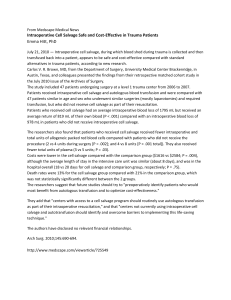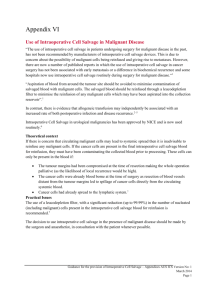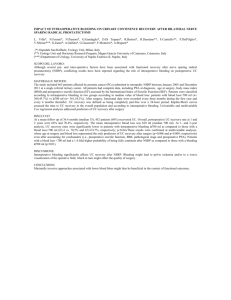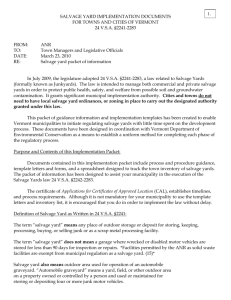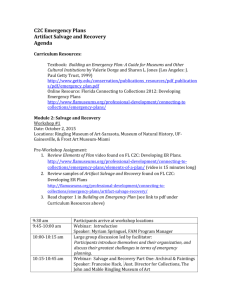Appendix I Intraoperative Cell Salvage
advertisement
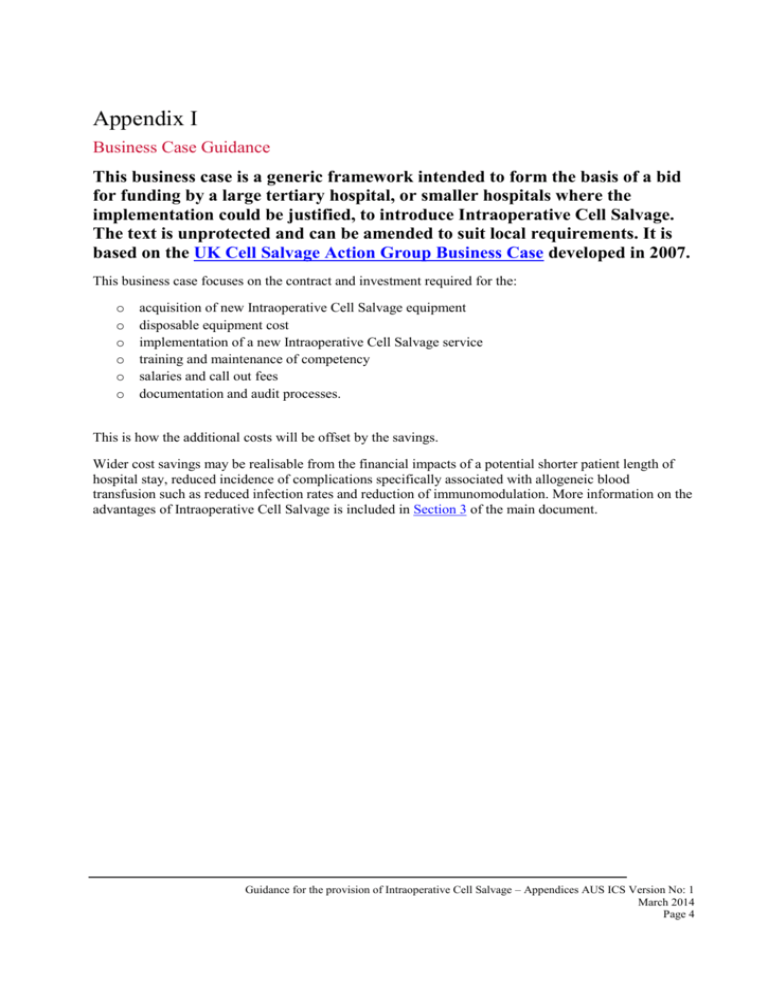
Appendix I Business Case Guidance This business case is a generic framework intended to form the basis of a bid for funding by a large tertiary hospital, or smaller hospitals where the implementation could be justified, to introduce Intraoperative Cell Salvage. The text is unprotected and can be amended to suit local requirements. It is based on the UK Cell Salvage Action Group Business Case developed in 2007. This business case focuses on the contract and investment required for the: o o o o o o acquisition of new Intraoperative Cell Salvage equipment disposable equipment cost implementation of a new Intraoperative Cell Salvage service training and maintenance of competency salaries and call out fees documentation and audit processes. This is how the additional costs will be offset by the savings. Wider cost savings may be realisable from the financial impacts of a potential shorter patient length of hospital stay, reduced incidence of complications specifically associated with allogeneic blood transfusion such as reduced infection rates and reduction of immunomodulation. More information on the advantages of Intraoperative Cell Salvage is included in Section 3 of the main document. Guidance for the provision of Intraoperative Cell Salvage – Appendices AUS ICS Version No: 1 March 2014 Page 4 The Provision of Intraoperative Cell Salvage Business Case Guidance for the provision of Intraoperative Cell Salvage – Appendices AUS ICS Version No: 1 March 2014 Page 1 Executive Summary Intraoperative Cell Salvage is a recognised blood conservation technique that is suitable for use in the elective and emergency surgical setting in a wide variety of specialities. Intraoperative Cell Salvage is a recommendation in the Patient Blood Management Guidelines: Module 2 – Perioperative1 and Module 4 – Critical Care2. Intraoperative Cell Salvage has recognised benefits for patients, with minimal associated risks e.g. reductions in allogeneic blood transfusions, lower infection rates and shorter hospital stays when compared to patients who receive allogeneic blood.3 This business case provides the tools to assess the financial impact of the implementation of a new intra-operative cell salvage service at hospital level. Intraoperative Cell Salvage, when used appropriately, can result in savings in blood budgets.4 It is important to identify the requirement and facilities for your specific hospital and adapt the purchase and implementation of cell salvage according to these needs. The introduction of Intraoperative Cell Salvage into (insert organisation, department, or speciality details here), could potentially generate annual savings of (enter figure here). Guidance for the provision of Intraoperative Cell Salvage – Appendices AUS ICS Version No: 1 March 2014 Page 2 Strategic Case Introduction The aim of this business case, with the support of (insert directorates here), is to justify the allocation of funds for the introduction of Intraoperative Cell Salvage into (insert organisation, department, or speciality details here) and to identify the cost benefit of such a service to (your hospital) Whilst allogeneic (donated) blood is an essential adjunct to health care, it is a limited resource (subject to the threat of future shortages), increasingly expensive and can present a source of risk for patients, in particular the risk of “wrong blood” incidents as reported by the Serious Hazards of Transfusion (SHOT) steering group in the UK.5 The recent systematic review conducted for the Perioperative Module of the Patient Blood Management Guidelines found five Level I studies and nine Level II studies of fair to good quality supporting the use of Intraoperative Cell Salvage1. The studies were predominantly in adult orthopaedic and cardiac surgical populations. The meta-analyses found that, overall, the incidence and volume of allogeneic blood transfusion were significantly lower for the individuals who received Intraoperative Cell Salvage.2 Carless et al estimated a saving of 0.68 units of allogeneic red blood cells per patient.3 The systematic review also found a moderate reduction in the risk of infection and an increase in postoperative haemoglobin concentration and haematocrit in patients undergoing off-pump coronary artery surgery3. Intraoperative Cell Salvage Intraoperative Cell Salvage can be used routinely in some areas of surgical practice. Using a modified aspiration line, blood lost from the surgical field is aspirated into a collection reservoir. Anticoagulant is used to prevent the collected blood from clotting. The modified aspiration line delivers the anticoagulant to the tip of the suction allowing the blood to mix with the anticoagulant as it is aspirated away from the surgical field. A filter in the collection reservoir removes large particulate debris. The salvaged blood is then centrifuged and washed to produce red blood cells suspended in saline which are sent to a reinfusion bag for reinfusion to the patient. The discarded products (plasma, platelets, anticoagulant etc) are mostly removed during processing. When used appropriately, by adequately trained staff, washed intraoperative cell salvage is a simple, safe and cost-effective method of reducing allogeneic transfusion. Guidance for the provision of Intraoperative Cell Salvage – Appendices AUS ICS Version No: 1 March 2014 Page 3 Advantages: Recognised benefits for patients: Preserves the patient’s own red blood cells. Reduces exposure to allogeneic blood and therefore reduces exposure to the risks associated with allogeneic blood transfusions. These risks include but are not limited to: incorrect blood component transfused, handling and storage errors, acute transfusion reactions, haemolytic transfusion reactions, transfusion-transmitted infection and transfusion associated graft versus host disease.5 Lower post-operative infection rates and shorter hospital stays when compared to patients who receive allogeneic blood.3 Intraoperative Cell Salvage has minimal risks (providing the manufacturer’s guidelines are followed). For volume dependent systems, providing the minimum volume of blood has been collected, processing is quick and blood can be reinfused within minutes of the start of processing. Disposable kits cost less than a unit of allogeneic red blood cells and can process very large volumes of blood. Intraoperative cell salvage is therefore a cost effective alternative to allogeneic blood (especially for large blood loss cases). Disadvantages: May be contraindicated in certain clinical circumstances (see Section 9 in the Guidance for the Provision of Intraoperative Cell Salvage). Adverse events such as hypotension associated with Intraoperative cell salvage is rare. Choice of Equipment There are a number of cell salvage devices available on the market, the most suitable equipment for (insert Organisation, department or surgical speciality here), was determined through a comparison based on the specific clinical requirements for (Inset your hospital name). The suitability of the manufacturer chosen will need to be assessed for each individual hospital. For aspects to keep in mind when choosing a manufacturer see Table 1. Guidance for the provision of Intraoperative Cell Salvage – Appendices AUS ICS Version No: 1 March 2014 Page 4 Table 1: List of questions essential to the introduction of a new intraoperative cell salvage service. EVALUATION OF INTRA OPERATIVE CELL SALVAGE SYSTEMS Important questions to ask when purchasing an original intraoperative cell salvage product: Most importantly: 1. 2. 3. 4. How many cases with significant blood loss are done annually? Which types of procedures or sub-specialities are involved? The availability and speed of availability of allogeneic blood in your unit. The ability of a manufacturer to support the implementation, education, maintenance and service required for the specific institution. 5. Does the requirement for intraoperative cell salvage in the specific unit mandate the availability of a dedicated autotransfusionist for intraoperative cell salvage, as opposed to the management of the intraoperative cell salvage process by, for example, an anaesthetic nurse and an anaesthetist? About the Manufacturer: 1. 2. 3. 4. 5. Who is the manufacturer? Where is the product manufactured? What number of sets are kept in stock? What quality systems are in place? What contingency plans are in place for availability of consumables if the current manufacturer is unable to supply? 6. Who provides the clinical “back-up” for this device in Australia? 7. Who provides support to the customers? 8. What support is provided? 9. How is the initial contact for new customers made? 10. How is training provided in hospitals and to whom? 11. What is the service quality of the backup service? 12. Response time by engineer? About the equipment: 1. 2. 3. 4. Is the product latex free? What is supplied in the pack? What additional items may need to be purchased? Does the system have universal fittings? About Processing: 1. Totally automated? 2. Can the system be used as semi-automated? Guidance for the provision of Intraoperative Cell Salvage – Appendices AUS ICS Version No: 1 March 2014 Page 5 3. Speed variability? 4. Can the volume of wash be adjusted? 5. Flexibility of equipment to suit different types of surgery where blood will be lost at different rates 6. Ability to separate collection and processing disposables About safety, risk and waste management: 1. 2. 3. 4. 5. How easy is the machine to clean? Contamination? Changing waste bag? Speed of the process? Quality of process, Heparin assay, HCT, Free Hb in supernatant? Training by company: 1. Is the training on site or off site? 2. Is there a training manual for the specific equipment available? 3. How is ongoing competency assessed and maintained? Other general issues: 1. 2. 3. 4. 5. 6. Is a patient information guide provided? Bowl size: Children, Small adults, Full-size? Is the vacuum on board or separate? Acceptability by users, autotransfusionists, surgeons and anaesthetic staff? Cost of machine (original purchase and maintenance)? Cost of disposables? It is important to use this information to identify the most suitable manufacturer and equipment for your particular institution. The (Enter machine chosen ) identified through this critical comparison process, as most suitable, had advantages over other commercially available equipment in the following areas: (Enter criteria from critical comparison process under which decision was made e.g. ease of set up, speed, Quality Control of final product etc) Guidance for the provision of Intraoperative Cell Salvage – Appendices AUS ICS Version No: 1 March 2014 Page 6 Economic Case Options for Procuring Equipment There are a number of options available for the introduction of Intraoperative Cell Salvage into (insert Organisation, department or surgical speciality here). These include: Outright purchase of the equipment of choice Outright purchase of alternative equipment of choice as financial constraints dictate Lease of equipment of choice via consumable charges Private Intraoperative Cell Salvage service hire for occasional elective cases or for 24 hour on call service. Prior to comparing costs, the most suitable option determined through a comparison based on the specific clinical requirements for this hospital is the (enter option here) option. This option was identified as most suitable based on the following criteria: (Enter criteria from critical comparison process under which decision was made e.g. quality, risk, patient benefit, availability etc) Financial Case The financial impact of outright purchase versus lease has been assessed by (enter details here e.g. Departmental Management Accountant). Table 2 compares the direct costs generated by purchase/leasing a cell salvage machine against the cost of the allogeneic blood avoided. In addition, although hard to estimate, savings may also be generated through reduced length of stay for patients having received intraoperative cell salvage when compared to patients receiving allogeneic blood transfusions. Guidance for the provision of Intraoperative Cell Salvage – Appendices AUS ICS Version No: 1 March 2014 Page 7 Table 2 Summary of Potential savings at Hospital Level Outright Purchase Lease Allogeneic Blood Savings $___________ $_____________ Costs generated by intraoperative cell salvage (year 1). Includes purchase of equipment and training of personnel etc. $___________ $_____________ Costs generated by intraoperative cell salvage (year 2 onwards). Consumables, competency maintenance, documentation and audit cost etc. $___________ $_____________ Annual Saving on Hospital Blood Budget (year 1) $___________ $_____________ Annual Saving on Hospital Blood Budget (year 2 onwards) $___________ $_____________ Guidance for the provision of Intraoperative Cell Salvage – Appendices AUS ICS Version No: 1 March 2014 Page 8 Table 3 Issues to be considered in the economic evaluation of outright purchase versus lease A spreadsheet should be compiled by the departmental accountant to determine the potential cost savings associated with the introduction of Intraoperative Cell Salvage into the Organisation. Financial benefits of introducing Intraoperative Cell Salvage should be determined locally. As an example the spreadsheet is likely to include the following information: Outright Purchase Number of cases suitable for intraoperative cell salvage performed each year Lease a $_______ $_______ Mean allogeneic blood usage per case for procedures b suitable for intraoperative cell salvage $_______ $_______ Current cost of a unit of allogeneic RBCs c $_______ $_______ Current blood usages costs avoided per annum axbxc $_______ $_______ Capital charges (equipment purchase) (Year 1) d $_______ Not Applicable Cost of intraoperative cell salvage Consumables (each) e $_______ $_______ Consumable costs per annum f=axe $_______ $_______ Maintenance contract costs per annum g $_______ $_______ Estimated electricity cost per intraoperative cell salvage case h $_______ $_______ Estimated electricity costs per annum i=axh $_______ $_______ Estimated costs for staff training Year 1 j $_______ $_______ Estimated costs for staff training Year 2 onwards k $_______ $_______ Additional costs incurred (year 1) d + f +g + i + j $_______ $_______ Additional costs incurred (year 2 onwards) f+g+I+k $_______ $_______ Annual cost saving - year 1 (Current blood usage costs avoided per annum – Additional costs incurred (year 1)) $_______ $_______ Guidance for the provision of Intraoperative Cell Salvage – Appendices AUS ICS Version No: 1 March 2014 Page 9 Annual cost saving - year 2 onwards (Current blood usage costs avoided per annum – additional costs incurred (year 2 )) $_______ $_______ Guidance for the provision of Intraoperative Cell Salvage – Appendices AUS ICS Version No: 1 March 2014 Page 10 CASE STUDY: During a retrospective study at the Royal Brisbane and Women’s Hospital (RBWH) in Brisbane, Queensland, the following was found: Estimating the cost of maintaining an intraoperative cell salvage service: The study was a retrospective audit, conducted in the RBWH in Brisbane, Australia, between January and December 2011.4 Over this period Intraoperative Cell Salvage was set up for 302 surgical cases in theatre and 242 units of intra-operatively salvaged blood was transfused (192 cases transfused, 110 cases setup and not transfused/discarded). 1. We calculated the cost of the intra-operative cell salvage service to our hospital (this is a rough estimate): Intraoperative Cell Salvage ongoing cost break down: Service Annual Cost Autotransfusionist $26221 Only after hours: On call (public holiday, nights weekends), called in or stayed in (1) Consumables $78395 Cost of cases processed and transfused* $63757 Cost of cases processed but not transfused* $14638 Machine: maintenance/ongoing cost (annual) $730 $105346 *The purchase of the machine and implementation costs were not included as this is a well-established service Cost per unit Intraoperative Cell Salvage summary: The cost of Intraoperative Cell Salvage for 242 units transfused in 2011 $105346 Therefore the average cost per unit of Intraoperative Cell Salvage ($105346/242) $435.32 2. The potential cost of allogeneic red blood cells as an alternative: Cost estimated Total per unit potential cost Allogeneic blood cost Intra-operative cell salvage Annual potential saving if intraoperative cell salvage used instead of allogeneic blood $733.33** $177466 $437.94 $105346 Potential saving $72120 **This amount is calculated for the RBWH case study based on methodology used in Wood et al7. Guidance for the provision of Intraoperative Cell Salvage – Appendices AUS ICS Version No: 1 March 2014 Page 11 Variables that depend on the local service setup and type of manufacturer: 1. Call out rate and frequency of call out for technical/autotransfusionist staff. This variable depends on the size and service setup in the specific hospital. If the number of cases with potential significant blood loss is small it might not be financially viable to justify a complete service with a “dedicated intraoperative cell salvage autotransfusionist” separate to the anaesthetic team. Alternatives would include the availability of a private intraoperative cell salvage service on a case by case or on call basis or the purchase of a very simple intraoperative cell salvage machine that could potentially allow the anaesthetic team to manage the salvaging and transfusion process, as well as the anaesthetic conduct. However this option should be thoroughly worked through and all parties satisfied with their ability to participate in a safe manner. 2. Ability to identify and salvage only those cases that would most likely be transfused (where predicted blood loss estimated more than 20% of blood volume). Every case where an intraoperative cell salvage setup is done and no blood re-infused could be seen as waste and might reduce the cost benefit of the entire service. On the other hand if these cases are set up for clinical indications or risk management reasons it may be justifiable. 3. Machine maintenance and disposable equipment cost would be specific to the type of manufacturer or device in use. 4. The absolute cost for a unit of allogeneic red blood cells is unknown. We estimated the cost for a unit of red blood cells from a study done in Australia, in 20066 and estimated the expected cost for 2011 by using the inflation rate for allogeneic blood in our hospital7. Other costs (not included in above study) to consider when doing a business case for intraoperative cell salvage: o o o o o Machine: 1) Initial outlay 2) Machine depreciation Training time Documentation Data collection Quality assurance: Impact on Haematology /Pathology services for quality assurance testing (examples include microbiology, HCT) Guidance for the provision of Intraoperative Cell Salvage – Appendices AUS ICS Version No: 1 March 2014 Page 12 Management Case Human Resources 1. Essential staff involved in the management of an Intraoperative Cell Salvage service: Lead Clinician The lead clinician should ideally be someone working in the theatre setting i.e. consultant anaesthetist / surgeon. Their role is to provide information, support and direction and includes: • • Informing clinical staff about the benefits of the Intraoperative Cell Salvage programme Agreeing on indications and operations where cell salvage can be used intra-operatively within the specific hospital • Informing and discussing with colleagues the use of Intraoperative Cell Salvage in unusual circumstances e.g. malignancy, sepsis, and amniotic fluid contamination. • Discuss the risks of these procedures and help make an informed judgement in matters such as the use of specific filters etc. • Be responsible for the overall programme within an organisation and ensuring quality systems are in place. Lead Manager Ideally a member of the theatre management team, for example the director of the Anaesthetic department. Their role is organisation and facilitation. They are responsible to: • Identify a lead autotransfusionist who will take on the role of cell salvage coordinator • Arrange for time for this person to become fully trained and competent • Be involved in the purchase of equipment, contracts for disposables, choice of consumables Cell Salvage Co-ordinator The co-ordinator should be a member of the theatre staff i.e. perfusionist, anaesthetic nurse or anaesthetic technician. Their role is functional, co-ordinating operations requiring intraoperative cell salvage. They are responsible for: • • • • • • • • • Training other members of staff in theatre and maintaining competency levels of trained staff Arranging for cell salvage to be available at a clinician’s request Keeping records of staff training Keeping records of all procedures undertaken Providing statistics for the Hospital Transfusion Auditing purposes Coordinating machine maintenance Writing organisational policies and protocols for the use of machines Auditing the use of cell salvage in conjunction with the Blood Transfusion Laboratory Undertaking quality control testing of re-infused red cells Guidance for the provision of Intraoperative Cell Salvage – Appendices AUS ICS Version No: 1 March 2014 Page 13 • Arrange, if appropriate, for cell salvage to be available 24/7 as cover for emergency procedures. The co-ordinator should be fully trained and competent in the operation of all machine types used in an Organisation. 2. In general the introduction of Intraoperative Cell Salvage is likely to also have an impact on the following staff groups: Intraoperative Cell Salvage Equipment Autotransfusionists (Department Practitioners, Anaesthetic Nurses, Scrub Staff, Anaesthetists, Midwives, Anaesthetists, and Surgeons from applicable subspecialities or any other staff group deemed appropriately qualified): The introduction of Intraoperative Cell Salvage will require an initial period of training and competency assessment. Once competency assessment has been completed, ongoing updates and refresher training will need to be delivered. Many manufacturing companies are kindly involved in ongoing competency training and assessments. Additional training may also be necessary if a training need is identified or a change of practice occurs. The resources to train new staff also need to be considered once the Intraoperative Cell Salvage service has been established. It is not mandatory to have a “dedicated autotransfusionist” for the Intraoperative Cell Salvage procedure; however, in certain emergency situations (catastrophic haemorrhage) a dedicated autotransfusionist may be necessary. Even though the requirement to have a dedicated autotransfusionist for intraoperative cell salvage would impact on the cost of the service this aspect would need to be assessed on an individual basis for each hospital. Anaesthetists: Anaesthetists should undergo basic training in Intraoperative Cell Salvage even if they will not be carrying out the procedure directly. The responsibility for the reinfusion of the Intraoperative Cell Salvage blood falls with the anaesthetist and/or surgeon and as such they should be aware of the potential benefits and risks and the procedure for reinfusing intraoperative Cell Salvage blood. Surgeons: The introduction of Intraoperative Cell Salvage may have a significant impact on surgeons. There are many aspects of Intraoperative Cell Salvage equipment in theatre, such as the use of lower vacuum levels, specific suction devices, or dedicated Intraoperative Cell Salvage “second suction devices” and contraindications to the use of Intraoperative Cell Salvage that may require a period of adjustment. Information technology: In cases where electronic data capture and documentation is required in the specific institution, information technology staff should be involved. Ongoing clinical governance: Record keeping and audit processes. Guidance for the provision of Intraoperative Cell Salvage – Appendices AUS ICS Version No: 1 March 2014 Page 14 Training Intraoperative Cell Salvage manufacturers usually offer a period of free training in the workplace to support the introduction of the equipment. This might include general awareness sessions for those not directly responsible for carrying out the Intraoperative Cell Salvage procedure (Surgeons, Anaesthetists, theatre staff who are not being trained to use the equipment), and intensive theory and hands on practical training in the classroom and the clinical environment for “key trainers” within the department. These “key trainers” are then usually responsible for training, supervising and competency assessment of the other Intraoperative Cell Salvage autotransfusionists in the department. It may be appropriate for a core number of staff to attend an intensive off site training course to reduce risk. Support National Blood Authority of Australia website: www.blood.gov.au Including: o o o o Generic Policy guidance that can be adapted to your local organisations educational resources and competency assessments Generic documentation and labelling Examples of procedures that would most likely present a cost benefit from the use of intraoperative cell salvage6 Auditing processes Organisational Risks The organisational risks should be minimal providing the equipment is used following the manufacturer’s guidance by adequately trained and competency assessed staff. The use of intraoperative cell salvage should decrease patient exposure to allogeneic blood and its associated risks. Guidance for the provision of Intraoperative Cell Salvage – Appendices AUS ICS Version No: 1 March 2014 Page 15 Conclusion Intraoperative Cell Salvage offers a way forward in reducing allogeneic blood use in appropriate surgical patient groups and has some cost benefit implications. The extent of the budgetary savings can be assessed via the information in Table 2. These savings and the benefit to patients as identified in this business case support the introduction of Intraoperative Cell Salvage into (insert organisation, department, or speciality details here). Recommendations Secure funding for the purchase/lease of equipment and continued running costs, to enable the provision of Intraoperative Cell Salvage for appropriate surgical procedures. Guidance for the provision of Intraoperative Cell Salvage – Appendices AUS ICS Version No: 1 March 2014 Page 16 References 1. National Blood Authority. Patient Blood Management Guidelines: Module 2 - Perioperative. 2012. 2. National Blood Authority. Patient Blood Management Guidelines: Module 4 - Critical Care. 2012. 3. Carless PA, Henry DA, Moxey AJ, O’Connell D, Brown T, Fergusson DA. Cell salvage for minimising perioperative allogeneic blood transfusion. Cochrane database of systematic reviews (Online) [Internet]. 2010;(4):CD001888. Available from: http://www.ncbi.nlm.nih.gov/pubmed/20393932 4. Roets M. A prospective observational study on Intra-operative Cell Salvage. Identifying adverse outcomes and surgical procedures which present the greatest cost-benefit for the use of Intraoperative Cell Salvage in the Royal Brisbane and Women’s Hospital. No Title. 2012. 5. Cohen H et al. Summary of 2011 Annual SHOT report. 2011. 6. Wood E et al. Transfusing a unit of Red Cells: What does it really cost? Australian Red Cross Blood Service, Flinders Medical Centre, Peter MacCallum Cancer Centre, Medical Society for Blood Management. Presented by the National Blood Authority Australia.; 2006. Guidance for the provision of Intraoperative Cell Salvage – Appendices AUS ICS Version No: 1 March 2014 Page 17

